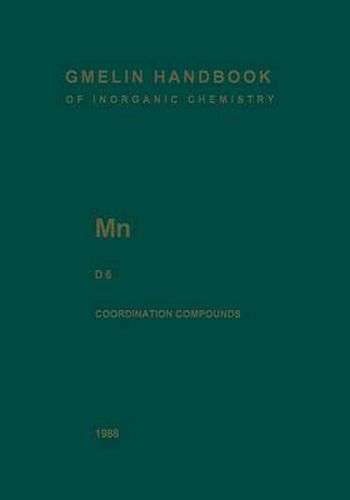Readings Newsletter
Become a Readings Member to make your shopping experience even easier.
Sign in or sign up for free!
You’re not far away from qualifying for FREE standard shipping within Australia
You’ve qualified for FREE standard shipping within Australia
The cart is loading…






This title is printed to order. This book may have been self-published. If so, we cannot guarantee the quality of the content. In the main most books will have gone through the editing process however some may not. We therefore suggest that you be aware of this before ordering this book. If in doubt check either the author or publisher’s details as we are unable to accept any returns unless they are faulty. Please contact us if you have any questions.
The present volume Manganese D 6 continues the description of the manganese com- plexes. The introduction on p. 1 shows the classes of complexes that have already been described in Chapters 1 through 29 in Volumes D1 to D 5. Complexes with Schiff bases and related compounds (e.g., hydrazones, semicarbazones, or thiosemicarbazones) are now described in Chapters 30 and 31 of this volume and complexes with carbazones, thiocarba- zones and formazans in Chapter 32. Complexes with Schiff bases play a central role in the development of coordination chemistry. The publications range from synthetic aspects to modern physicochemically or biochemically relevant investigations on these compounds. The huge number of studies results from the fact that these ligands may contain various donor atoms, in addition to the azomethine group, and thus can occur with variable denticities. About 1700 compounds derived from 808 different ligands are described in the present volume. Their arrangement is by ligand type and number of azomethine groups.
$9.00 standard shipping within Australia
FREE standard shipping within Australia for orders over $100.00
Express & International shipping calculated at checkout
This title is printed to order. This book may have been self-published. If so, we cannot guarantee the quality of the content. In the main most books will have gone through the editing process however some may not. We therefore suggest that you be aware of this before ordering this book. If in doubt check either the author or publisher’s details as we are unable to accept any returns unless they are faulty. Please contact us if you have any questions.
The present volume Manganese D 6 continues the description of the manganese com- plexes. The introduction on p. 1 shows the classes of complexes that have already been described in Chapters 1 through 29 in Volumes D1 to D 5. Complexes with Schiff bases and related compounds (e.g., hydrazones, semicarbazones, or thiosemicarbazones) are now described in Chapters 30 and 31 of this volume and complexes with carbazones, thiocarba- zones and formazans in Chapter 32. Complexes with Schiff bases play a central role in the development of coordination chemistry. The publications range from synthetic aspects to modern physicochemically or biochemically relevant investigations on these compounds. The huge number of studies results from the fact that these ligands may contain various donor atoms, in addition to the azomethine group, and thus can occur with variable denticities. About 1700 compounds derived from 808 different ligands are described in the present volume. Their arrangement is by ligand type and number of azomethine groups.